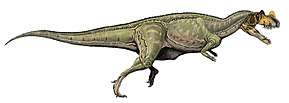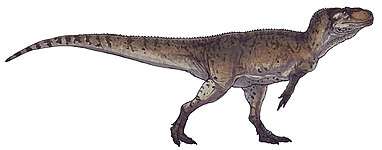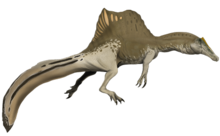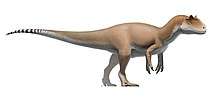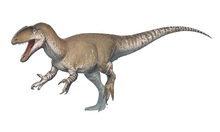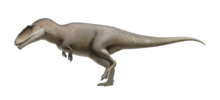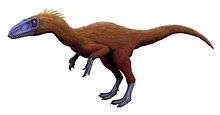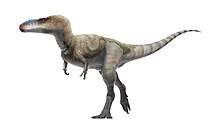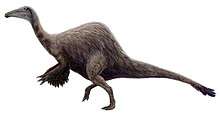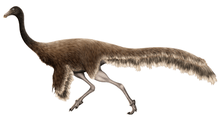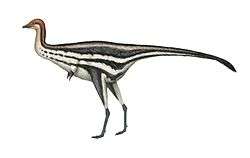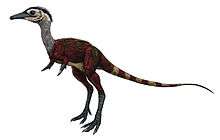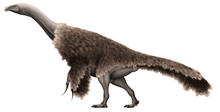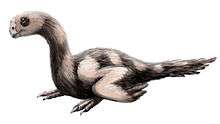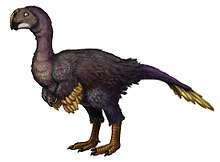Tratayenia
Tratayenia is an extinct genus of megaraptoran theropod dinosaurs known from remains found in the Santonian-age Bajo de la Carpa Formation of Argentina.[1] The type and only species, Tratayenia rosalesi, was described in March 2018.[2]
| Tratayenia | |
|---|---|
| Scientific classification | |
| Kingdom: | Animalia |
| Phylum: | Chordata |
| Clade: | Dinosauria |
| Clade: | Saurischia |
| Clade: | Theropoda |
| Clade: | †Megaraptora |
| Family: | †Megaraptoridae |
| Genus: | †Tratayenia |
| Type species | |
| †Tratayenia rosalesi Porfiri et al., 2018 | |
Tratayenia can be distinguished from other megaraptorans on the basis of three autapomorphies (unique derived features) of the front portion of each dorsal vertebra, as well as a single autapomorphy of the sacrum. Tratayenia is the youngest known genus of megaraptoran, having lived only about 83 million years ago.
Discovery and naming
The holotype consists of a well-preserved partial skeleton, MUCPv 1162, which includes several articulated portions of the backbone. One portion of the skeleton is a string of five dorsal vertebrae, likely the seventh to eleventh dorsals. The largest articulated portion of the skeleton is a string of vertebrae including the last two dorsals as well as the five sacrals and much of the right ilium. Other preserved bones include two partial dorsal ribs and fragments of the pubis and ischium.[1]
This skeleton was first discovered in 2006 at a Bajo de la Carpa Formation fossil site by Universidad Nacional del Comahue technician Diego Rosales. Shortly thereafter it was excavated by UNC paleontologist Juan D. Porfifi. Porfiri and his colleagues published a preliminary report on the new dinosaur in a 2008 abstract, and suggested that it may have been a relative of Carcharodontosauridae.[3] In 2018, the new taxon was described with the generic name Tratayenia, named after Tratayén, the fossil site at which it was excavated. The specific name Tratayenia rosalesi honors Diego Rosales.[1]
Description
Tratayenia was a medium-sized megaraptoran, growing up to 8 metres (26 ft) long. It was closely related to genera such as Megaraptor, Australovenator, and Murusraptor. Like most other megaraptorans, it probably had large claws on its hands for use in hunting prey. Analysis of the Baja de la Carpa indicates that Tratayenia may have been geologically the youngest megaraptoran yet discovered. Tratayenia is also the largest-bodied carnivorous animal named from the Bajo de la Carpa Formation, reinforcing the hypothesis that megaraptorids were apex predators in southern South America from the Turonian through the Santonian or early Campanian, following the extinction of carcharodontosaurids.[1][2]
Dorsal vertebrae
The dorsal vertebrae were tall and narrow, with large pits known as pleurocoels on the side of their centra (spool-shaped main portion). These features are common in the vertebrae of large carnivorous theropods. Some of the vertebrae had fragments of bone in the pleurocoels, which were likely remnants of thin bony walls known as septa which divided the pits. Septa are also known in other megaraptorans and carcharodontosaurids. The neural arches of the vertebrae are taller and narrower in Tratayenia than in most other theropods. The tubular transverse processes (rib facets) project upwards and to the side. A large and deep excavation is located directly below each transverse process, bounded from the front and rear by thin laminae (ridges). The front edge is formed by the paradiapophyseal lamina and the rear edge is formed by the posterior centrodiapophyseal lamina. These features are also known in the megaraptoran Murusraptor.[1]
The prezygapophyses (front vertebral joint plates) are rectangular when see from the side, with the front and lower edges converging at nearly a right angle. This is an autapomorphy (unique adaptation) of Tratayenia. A ridge known as a prezygodiapophyseal lamina connects the prezygapophyses to the transverse processes. Another autapomorphy of Tratayenia is that the prezygodiapophyseal lamina is parallel to the paradiapophyseal lamina. Other theropods either have a weakly developed (or absent) paradiapophyseal lamina, or one which is angled relative to the prezygodiapophyseal lamina. The front edge of each vertebra has a third autapomorphy, related to two pairs of laminae (four total) connecting the prezygapophyses to the neural spines. At the base of the neural spines, the two laminae comprising each pair are very close together. But as the laminae get closer to the prezygapophyses, they diverge into a shape akin to an inverted Y. There are two of these inverted Y-like structures visible from the front, for both the left and right sides of a vertebra.[1]
The postzygapophyses (rear vertebral joint plates) are more typical in shape, and the rear edge of each vertebra has a small, blade-like hyposphene which splits into three ridges from below. The neural spines are tall and rectangular when seen from the side, and uniformly thin when seen from the front. Most are completely vertically, but one of the dorsal vertebrae preserved near the hip slightly inclines forward as in various allosauroids. Preserved rib fragments are curved and hollow. They connected to the vertebrae by means of two distinct condyles, separated by a large opening which may have been continuous with the inner cavity.[1]
Sacrum and hip
Tratayenia has five sacral (hip) vertebrae, as is the norm for theropods. They are very similar to the dorsal vertebrae in various aspects, such as the presence of large pleurocoels, tall and narrow centra, and laminae-bound excavations below the transverse processes. However, they only have a single autapomorphy: the anteroposterior (front-to-back) width of the neural spine increases drastically in the second to fifth sacral vertebrae compared to the first vertebra. In fact, the fifth sacral's neural spine is twice as long anteroposteriorly than that of the first. This trait has also been observed in Tyrannosaurus and an unnamed megaraptoran sacrum (SNMS 58023) from the Romualdo Member of the Santana Formation in Brazil,[4] so its status as an autapomorphy of Tratayenia is not concrete. Some of the sacral vertebrae have neural spines which are fused together, and the last three curve backwards. The fourth sacral has a shape similar to those of the Santana Formation sacrum.[1]
The ilium (upper blade of the hip) was heavily pneumatized, meaning that it was filled with air pockets. Pneumatization of the ilium is most common in megaraptorans among theropods, as seen in taxa such as Aerosteon and Murusraptor. The outer surface of the ilium is perforated by several pneumatic pores, similar to that of Aerosteon, but the upper edge of the bone is straight, in contrast with the curved ilium of Aerosteon. A bone identified as the pubic boot (expanded tip of the pubis) has been found in the holotype, as well as fragments of the ischium, which has the form of a long, thin shaft covered in grooves.[1]
Classification
Megaraptorans have very controversial relations to other theropods. The first mainstream hypothesis is that they are carnosaurs, distantly related to Allosaurus and more closely related to Neovenator and carcharodontosaurids. The second popular hypothesis considers them to be basal tyrannosauroids, part of the coelurosaur lineage which includes the crested proceratosaurids as well as the famous tyrannosaurids such as Tyrannosaurus.[5] A third hypothesis also considers them to be coelurosaurs, but outside Tyrannosauroidea and basal to practically all other groups of Coelurosauria. Porfiri et al.'s description of Tratayenia prefers this third hypothesis.[1]
The cladogram below follows the strict consensus (average result) of the 12 most parsimonious trees (the simplest evolutionary paths, in terms of the total amount of sampled features evolved or lost between sampled taxa) found by Porfiri et al. (2018)'s phylogenetic analysis.[1] Although the results are different, the methodology analysis was practically identical to that of Apesteguia et al. (2016), only differing in the fact that it incorporated Tratayenia and Murusraptor, two megaraptorans not sampled in the analysis of Apesteguia et al.[5]
| Avetheropoda |
| ||||||||||||||||||||||||||||||||||||||||||||||||||||||||||||||||||||||||||||||||||||||||||
Paleoecology
Tratayenia lived in the Bajo de la Carpa Formation alongside many lizards and turtles, the snake species Dinilysia patagonica, many birds such as Patagopteryx deferrariisi, a diverse amount of crocodylomorphs and many dinosaurs such as Viavenator exxoni and Traukutitan eocaudata.
See also
References
- Porfiri, Juan D; Juárez Valieri, Rubén D; Santos, Domenica D.D; Lamanna, Matthew C (2018). "A new megaraptoran theropod dinosaur from the Upper Cretaceous Bajo de la Carpa Formation of northwestern Patagonia". Cretaceous Research. 89: 302–319. doi:10.1016/j.cretres.2018.03.014.
- Fonseca, Lurdes (28 March 2018). "Just out | A new megaraptoran theropod dinosaur from the Upper Cretaceous Bajo de la Carpa Formation of northwestern Patagonia @ Cretaceous Research". Paleowire.
- Porfiri, Juan D.; Calvo, Jorge O.; Juarez Valieri, Ruben D.; Santos, Dominica D. (2008). "A new large theropod dinosaur from the Bajo de La Carpa Formation (Late Cretaceous) of Neuquén, Patagonia". Ill Congreso Latinoamericano de Paleontologia de Vertebrados.
- Aranciaga Rolando, Alexis M.; Brissón Egli, Federico; Sales, Marcos A.F.; Martinelli, Agustín G.; Canale, Juan I.; Ezcurra, Martín D. (2018). "A supposed Gondwanan oviraptorosaur from the Albian of Brazil represents the oldest South American megaraptoran". Cretaceous Research. 84: 107–119. doi:10.1016/j.cretres.2017.10.019. ISSN 0195-6671.
- Apesteguía, Sebastián; Smith, Nathan D.; Juárez Valieri, Rubén; Makovicky, Peter J. (2016-07-13). "An Unusual New Theropod with a Didactyl Manus from the Upper Cretaceous of Patagonia, Argentina". PLoS ONE. 11 (7): e0157793. doi:10.1371/journal.pone.0157793. PMC 4943716. PMID 27410683.
